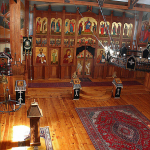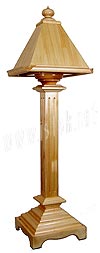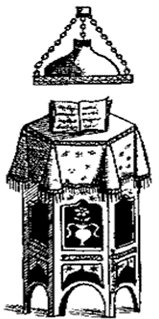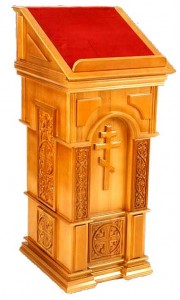by Fr. John A. Peck
The final installment of our five part series. A Short History of the Liturgical Location for Preaching: The Ambo, the Pulpit and the Lectern.
You can read from the beginning by clicking HERE.
The Lectern (Analogion)


The Lectern (from the Latin lectus, past participle of legere, “to read”) is a reading desk with a slanted top, usually placed on a stand or affixed to a some other form of support, on which documents or books are placed as support for reading aloud. To facilitate eye-contact and improve posture when facing an audience, lecterns may have adjustable height and slant. Lecterns are often eagle shaped to symbolize the Gospel according to St John the Apostle. Persons use lecterns while standing.
The lectern is usually the stand on which the Bible rests and from which the “lessons” (reading from Scripture) are read during the service. The lessons may be read or chanted by a priest, deacon, minister, or layperson, depending upon the liturgical traditions of the community. In protestant churches, the lectern became a central architectural feature, replacing the altar (in location and importance) and being exalted over the ‘communion table.’ In other words, the pulpit became the lectern and was often moved to the center. The lectern is normally set in front of the pews, so that the reader or speaker faces the congregation.
Lecterns are often made of wood, though brass, marble and other materials are more and more available. They may be either fixed in place or portable.
Portable Lecterns are often used in many parish Churches for the reading of the Gospel, and for the sermon afterward.
The Analogion (plural: analogia) is a lectern or slanted desk or stand on which icons or the Gospel Book are placed for veneration by the faithful in the Orthodox Church. Traditionally, the analogia were reading desks for the Epistle and Gospel, remained at the sides of the choir, as they are today and are chiefly used for reading or singing parts of the liturgy.
The analogion is normally slanted slightly, to make it easier for the one standing in front of it to see the icon or book laid on it. The analogion may have four legs or only one in the center. It is often covered with rich cloth (antipendia) which either partially or completely covers the analogion on all sides. Some analogia are made made so they fold for easy portability, some are intricately carved of fine wood, and some are simple framework intended to be completely covered with cloth. They are normally light enough to be moved without too much difficulty.
 There is also a type of analogion which is used in the kliros by the chanters. This often has two or three sides and turns to allow the singers to more easily use the numerous liturgical texts required during the services.
There is also a type of analogion which is used in the kliros by the chanters. This often has two or three sides and turns to allow the singers to more easily use the numerous liturgical texts required during the services.

There is an older Greek design for this type of analogion that is octagonal with a flat top instead of slanted. This style is still found in use on Mt. Athos and at other ancient monasteries throughout the world. Sometimes this type of analogion is intricately inlaid with mother of pearl or other semi-precious materials.
A similar piece of furniture is called the tetrapodion which is a table which can be set in the center of the church, usually covered with a cloth, and upon which objects are placed to be blessed.
Analogia are used for the veneration of icons, usually with a candlestand beside or behind it, or an oil lamp burning above it. The candlestand may hold one candle and be used to shine light on the icon, or it may have places for the faithful to offer candles as they venerate the icon.
 On higher-ranking feasts of the church year, when the chanting of the Polyeleos is called for, an analogion is placed in the center of the temple (i.e., the nave of the church) with candles, and the icon of the feast being celebrated is placed thereon.
On higher-ranking feasts of the church year, when the chanting of the Polyeleos is called for, an analogion is placed in the center of the temple (i.e., the nave of the church) with candles, and the icon of the feast being celebrated is placed thereon.
At the highpoint of the service, all of the lights in the church are lit and the clergy and people gather around the icon on the analogion in the center of the temple for the chanting of festive hymns and the reading of the Matins Gospel lesson.
When a priest or bishop hears Confession, he will do so standing beside an analogion on which has been placed a Gospel Book and a Cross. The penitent will venerate the Gospel and Cross and then kneel before the analogion, for the confession.
Where to get them?
After this series of articles, you may be wondering what it would actually take to install these in your parish. The answer is not so much as you might think. We’ve compiled a list (albeit incomplete) of vendors where the following can be purchased. Now, we have not received any compensation for offering these links (too bad!), and we are certainly interested in more. If you know of a vendor who supplies these items, let us know by clicking here.
Ambones
Right now, classically designed ambones are, as far as I know, not being manufactured. However, if one desired to have one made, I would start with this vendor:
- King Richard’s – this vendor’s ambones are small ambones, or unattached pulpits rather than the classic ambo, but they are marvelous in marble and wood, and would be my first choice should you wish to reconstruct a classic ambo, or simply add a magnificent small ambo to your church. I recommend you take some time to examine their offerings, and imagine the possibilities in your own parish.
Pulpits
With pulpits, as we define them, one has more choices!
- Orama World – this vendor’s hand carved pulpit would match many an iconostasis already installed.
- Crown Church Supply – has two hand carved pulpits in their catalog.
- Dimitrios Klitsas – this Master Woodcarver is in the US and has created pulpits for Orthodox churches.
- Steve A. Kavroulakis Co. – excellent hand carved pulpits for Orthodox Churches.
- King Richard’s – by far the most excellent selection of hand carved wood or marble pulpits.
Lecterns & Analogia
- St. Mark Workshop – hand made lecterns and analogia by an Orthodox priest in the US.
- Kizki Woodworks – a vendor who manufactures hand made lecterns & analogia.
- Orama World – again, this vendor has several hand carved lecterns.
- Crown Church Supply – has several hand carved lecterns and more.
- Istok Enterprises– this vendor has a wonderful selection of lecterns.
- Steve A. Kavroulakis Co. – excellent hand carved lecterns for Orthodox Churches.
- King Richard’s – KR has an excellent selection of hand carved wood or marble lecterns.
